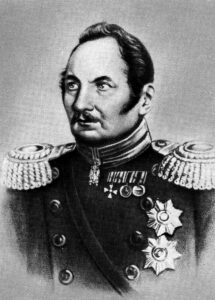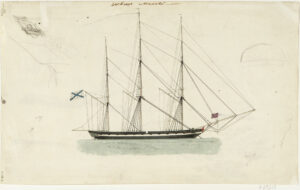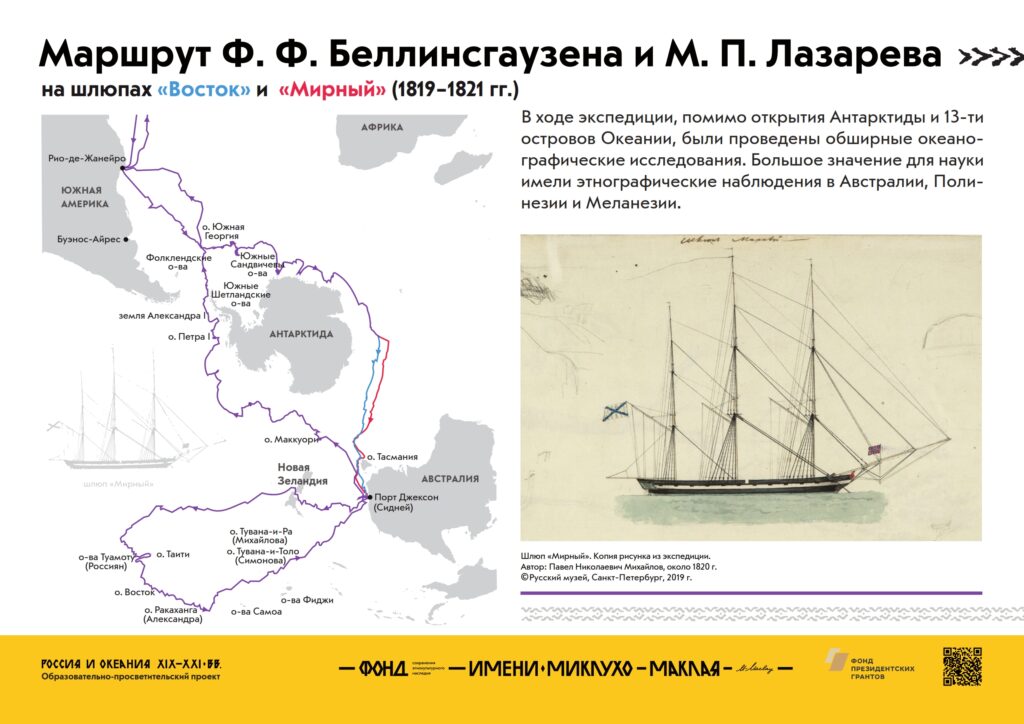Expedition of Bellingshausen and Lazarev (1819-1821). Discoveries and explorations in Oceania. Discovery of Antarctica
The aims of the expedition were to find land near the South Pole and to explore the southeastern Pacific. The expedition visited Australia, New Zealand, the Tuamotu Islands, Tahiti, the Rakahanga Atoll (northern Cook Islands), and Ono Island (Fiji), where important ethnographic observations were made. An outstanding achievement of the expedition was the discovery of a new continent, Antarctica. Previously unknown islands were also mapped and extensive oceanographic research was undertaken.
In the XVIII and XIX centuries, European navigators faced the challenge of exploring the waters of the Southern Ocean, or the Arctic Ocean (sometimes called the combination of the Pacific, Indian and Atlantic Oceans in the area of the Southern Polar Circle) and proving or disproving the existence of a sixth continent there, which in the late XIX century would be called Antarctica. At that time, the existence of a large land mass near the South Polar Circle was only a hypothesis.
The first attempt to find the hypothetical continent was made by the famous British navigator James Cook. In 1773, he crossed the South Polar Circle for the first time in history, but he could not see the unexplored continent because of insurmountable ice. As a result, Cook concluded that it was impossible to reach it. The navigator's authority was so great that no attempt was made for the next 46 years. The first Russian Antarctic expedition by Fabian Gottlieb von Bellingshausen and Mikhail Petrovich Lazarev started in 1819.
Adam Johann von Krusenstern, who led the first Russian circumnavigation in 1803-1806, was involved in the preparation of the project, in which Bellingshausen also took part. It was Krusenstern who proposed him as the leader of the Antarctic expedition.
In January 1819, the British navigator William Smith, sailing through the Drake Passage (between Antarctica and South America), was diverted by a strong wind and accidentally discovered the South Shetland Islands, which were very close to Antarctica. Perhaps, having received news of the discovery of these islands, the Russian leadership reasonably assumed that the British would soon embark on a thorough exploration of them, which could lead to the discovery of the Southern Continent. With the departure of Napoleon's French Empire from the world stage, Great Britain became Russia's strongest competitor, which naturally sought to discover the southern continent before the British, to show that Russia was not inferior to Great Britain as a maritime power.
Indeed, Great Britain began preparing an expedition to the South Shetland Islands to explore them, declare them the property of the British Crown and find out if they were part of the hypothetical Southern Continent. A British naval officer, Edward Bransfield, was appointed to lead the expedition. Preparations for the voyage continued until the end of 1819. In December 1819, the ship "Williams", commanded by Bransfield, sailed off from Valparaiso, Chile. By then, Bellingshausen's expedition had already been on the road for about five months. However, considering that Valparaiso was much closer to Antarctica than Kronstadt, and that Bransfield was heading for the South Shetland Islands, which were quite close to the Antarctic Peninsula, while Bellingshausen had to sail through the ice from the South Sandwich Islands, the fact that the Russians discovered Antarctica before the British could be explained either by great luck or by the fact that the Russians had a goal to be first and put considerable effort into it.
Either way, the Russian discovery of Antarctica on 16 January 1820 (or 28 January GC) occurred just two days before Bransfield sighted its shores (30 January GC).
The second leader of the expedition was Lieutenant M. P. Lazarev, another famous Russian navigator.

The first Russian Antarctic expedition included two sailing ships: "Vostok", commanded by Bellingshausen, who also commanded the expedition, and "Mirny", commanded by Lazarev. Both ships were not equipped to navigate through the ice. The total number of crew on the two ships was 190.
The main aim of the expedition was to get as close as possible to the South Pole and discover the lands there. The crews of "Vostok" and "Mirny" were tasked with research in the natural sciences and ethnography. It was also ordered to search for new islands in the South Pacific. The expedition included the astronomer I. M. Simonov, the ship's physicians J. Berg and N. A. Galkin, the painter, Academician of the Imperial Academy of Arts P. Mikhailov, who sketched new lands, animals, plants and people.
The voyage started in July 1819 from Kronstadt. In November 1819, "Vostok" and "Mirny" arrived in Rio de Janeiro, Brazil, from where "Vostok" and "Mirny" set sail for the south of the Atlantic Ocean, to South Georgia Island. On the way from South Georgia to the South Sandwich Islands, the Russian expedition discovered three islands, which were named after Admiral Jean Baptiste Prevost de Sansac, marquis de Traversay.
From the southern Sandwich Islands, the ships sailed eastwards, occasionally turning south and attempting to approach the theoretical mainland, but, as with Cook, ice was in their way. Because of this obstacle, "Vostok" and "Mirny" were forced to continue eastwards, along the ice edge, in difficult and often dangerous conditions of cold, wind and snowfall.
Finally, on 16 January (January 28, GC) 1820, the shore appeared, the edge of the ice shelf, which was named after Bellingshausen. Thus was the discovery of Antarctica by Russians.
The expedition then continued to explore Antarctic waters and once again approached the shores of Antarctica, the area now known as Enderby Land.
By then the ships were already badly damaged by storms and needed urgent repairs. Further sailing through the ice was too dangerous and in early March Bellingshausen and Lazarev decided to set a course for Australia.
Before this, the Russian sailors managed to catch an amazing Antarctic phenomenon: the aurora borealis, which flooded the entire sky, making it as bright as daylight even at night. The ship's painter P. Mikhailov made a magnificent sketch of this majestic phenomenon.
On 29 March 1820, "Vostok" anchored in Port Jackson (now Sydney), Australia. Bellingshausen's expedition team stayed in Australia for over a month. During this time the ships were repaired, and by the end of May "Vostok" and "Mirny" arrived in New Zealand. Here the Russian sailors met the indigenous Maori inhabitants. The expedition's notes about the communication with them, Mikhailov's drawings and the collection of artefacts became invaluable evidence of Maori life before British colonization of New Zealand.
The expedition team spent in New Zealand only about a week, stocked with ship timber and set off for what is now called French Polynesia. On 29 June 1820, the ships approached Oparo Island (now Rapa Iti), whose inhabitants, to Bellingshausen's delight, did not have tattoos on their faces, which the captain greatly disliked on the faces of New Zealand Maori.
After leaving Oparo (Rapa Iti), the expedition team set sail for the Tuamotu Islands (now part of French Polynesia). On 6 July 1820, "Vostok" and "Mirny" approached Luka Island (now Hao); on the same day the expedition encountered another coral atoll on its way, which had not yet been described by any European traveler. Bellingshausen named the atoll after the Russian admiral Möller (now Amanu in the Tuamotu Archipelago). In the morning, July 10, the sailors again saw another undescribed island, which the explorer named after Count A. A. Arakcheyev (now Fangatau). On 12 July, two more atolls, named after P. M. Volkonsky (now Takume) and Prince Michael Andreas Barclay de Tolly (now Raroia), were discovered. On July 13, the expedition team discovered the uninhabited island of Nihiru. During the next few days more aqtolls were found in the Tuamotu Archipelago, which were named after famous Russian men: A. P. Yermolov (now Taenga), M. I. Kutuzov (today Makemo), N. N. Raevsky, Fabian Gottlieb von der Osten-Sacken, P. V. Chichagov, M. A. Miloradovich, P. Wittgenstein and A. S. Greig.
In addition to the unknown islands on their way on 19 July 1820 "Vostok" and "Mirny" also encountered the Palliser Islands, discovered by J. Cook. Bellingshausen decided to name the whole chain of coral islands "Russian Islands". He included the Palliser Islands because, although they had been discovered by the British navigator Cook, it was the Russian sailors who gave a detailed description and clarification of their location.
After the Russian Islands, "Vostok" and "Mirny" set sail for Tahiti (now a part of French Polynesia) so that the crew could rest and replenish food and fresh water supplies. On the way, on 20 July 1820, the Russian sailors went ashore on the uninhabited island of Matea (now Makatea), where they found four boys who had been blown out to sea from their home island and washed up on Makatea. The boys were taken on board and sent to Tahiti, where the Russian expedition team was warmly welcomed by King Pōmare II. On the day of departure, the Tahitians donated to the expedition team many provisions: fruits and vegetables, as well as pigs. The children, picked up on the Island of Matea (Makatea), found their relatives in Tahiti and stayed with them.
On 27 July 1829, "Vostok" and "Mirny" left Tahiti and set sail for Krusenstern Atoll (now Tikehau, Tuamotu Archipelago, French Polynesia), discovered in 1816 by the Russian navigator Kotzebue. The expedition of Bellingshausen soon discovered Lazarev Atoll (now Mataiva, Tuamotu Archipelago) and Vostok Island in the Line Islands (the island retains the name to this day). On 8 August, navigators rediscovered the Island of Beautiful People (Gente Hermosa), so named by the Spanish in 1606, and renamed it Alexander Island (now Rakahanga in the northern Cook Islands). On August 19, two small islets in the Fiji archipelago (Melanesia) were discovered and named after the astronomer I. M. Simonov (now Tuvana-i-Colo) and the painter P. N. Mikhailov (now Tuvana-i-Ra). They visited Ono Island (now Ono-i-Lau, Lau Islands, Fiji), which Bellingshausen liked very much - the locals made a good impression on him, and he even gave them the seeds of various crops, as well as a gun, powder, bullets and taught how to use them.
On 10 September 1820, "Vostok" and "Mirny" arrived in Port Jackson again. On 31 October 1820, the ships hoisted their sails and set sail for the harsh polar waters. On the way to Antarctica, they came upon uninhabited Macquarie Island, off the south coast of New Zealand, where they encountered Australians, whose livelihood was hunting and fat-gasming sea elephants. Having made a supply of fresh water, the Bellingshausen expedition left Macquarie Island and headed again to Antarctica. As on the previous occasion, the ships travelled around this continent in an easterly direction. In January 1821 they approached the impassable ice and turned north. They discovered Peter I Island, Alexander I Island and a number of islands in the South Shetland archipelago. Bellinshausen's expedition left the Shetland Islands for Rio de Janeiro, thence for Europe and returned to Kronstadt on 24 July (August 5, GC) 1821. The voyage lasted 751 days.
The first Russian Antarctic Expedition of Bellingshausen and Lazarev, unique both in its complexity and effectiveness, is considered one of the greatest achievements in human history. In the course of the expedition 29 islands and the whole continent Antarctica were discovered, a wealth of natural scientific and ethnographic material was collected, sketches of Antarctic landscapes were made for the first time and local fauna was captured.
It is noteworthy that during the voyage to Oceania none of the islands discovered by the expedition was named after Bellingshausen himself. But four years later, another Russian navigator, Otto von Kotzebue, who in 1823-1826 made his second circumnavigation on the ship "Predpriyatie", discovered a new atoll in the Tuamotu Archipelago and named it Bellingshausen Island (now Motu One).
Литература
Балкли Р. Первые наблюдения материковой части Антарктиды: Попытка критического анализа // Вопросы истории естествознания и техники. 2016. № 1. С. 41–56. https://elibrary.ru/item.asp?id=20933943
Брансфилд, Эдвард // Энциклопедия «Вокруг света». https://ru-wiki.ru/wiki/%D0%91%D1%80%D0%B0%D0%BD%D1%81%D1%84%D0%B8%D0%BB%D0%B4,_%D0%AD%D0%B4%D0%B2%D0%B0%D1%80%D0%B
Двукратные изыскания в Южном Ледовитом океане и плавание вокруг света в продолжение 1819, 1820 и 1821 годов, совершенные на шлюпах «Востоке» и «Мирном» под начальством капитана Беллинсгаузена, командира шлюпа «Востока», шлюпом «Мирным» начальствовал лейтенант Лазарев. СПб., 1831. https://e-libra.ru/read/208149-dvukratnye-izyskaniya-v-yuzhnom-ledovitom-okeane-i-plavanie-vokrug-sveta-v-prodolzhenie-1819-1820-i-.html
Забытые первопроходцы // Новостное издательство «Пресса». 19.10.2019. http://ryazpressa.ru/zabytye-pervoprohodczy/
Заглянуть за горизонт. История открытия Антарктики – в экспонатах выставки Музея героев. https://www.mos.ru/news/item/66612073/4
К 200-летию открытия Антарктиды экспедицией Ф. Ф. Беллинсгаузена и М. П. Лазарева на шлюпах «Восток» и «Мирный» // Российский государственный архив военно-морского флота. https://rgavmf.ru/virtualnye-vystavki/k-200-letiu-otrritiya-antarktidi
Каланов В. Изучение Южного океана // Энциклопедия «Знание – сила». — http://znaniya-sila.narod.ru/solarsis/zemlya/earth_ocean_18.htm
195-летие со дня открытия островов Беллинсгаузена // Музей морского флота. 05.04.2019. http://www.mmflota.ru/index.php/news/459-195-letie-so-dnya-otkrytiya-ostrovov-bellinsgauzena
Хорошевский А. Отто Евстафьевич Коцебу. Путешествия вокруг света. М., 2014. https://www.litres.ru/otto-kocebu/puteshestviya-vokrug-sveta/chitat-onlayn/
Here is a list of toponyms mapped during these expeditions:
Rakahanga (Alexander Island)
Fangatau (Arakchev Island)
Raroia (Barclay de Tolly Atoll)
Beregis Reef
Fakarava (Wittgenstein Atoll)
Takume (Volkonsky Atoll)
Vostok Island
Niau (Greig Atoll)
Taenga (Yermolov Atoll)
Makemo (Kutuzov Atoll)
Mataiva (Lazarev Atoll)
Faaite (Miloradovich Atoll)
Tuvana-i-Ra (Mikhailov Island (Atoll))
Amanu (Möller Atoll)
Katiu (Osten-Sacken Atoll)
Tepoto (Raevsky Islands)
Russian Islands
Tuvana-i-Colo (Simonov Island (Atoll))
Tahanea (Chichagov Atoll)






